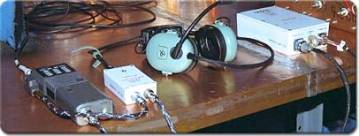|
Working the International Space Station |
|||
|
(Originally published in the Augst 2002 LEARA Spirit of '76 and '88) |
|||
|
The club picnic turned out to be very exciting for me. While Eric N8AUC was calling the door-prize ticket numbers, Dave WB8APD, Bob W2THU and a couple others beside myself were able to catch the International Space Station (ISS), on 2-meter FM voice working stations with just a HT and a rubber-duckie antenna. For most of the ten-minute pass we were able to hear Valeri Korzun RZ3FK, ISS Expedition 5 Commander making one contact after another in rapid-fire succession. The signals, weak and scratchy at first quickly shot up to S9 and better as the spacecraft rose above the horizon. Signal strengths pretty much stayed this way until near the end of the pass when they quickly dropped and faded back into noise. This was cool because up until now I had only been able to copy Earth-to-Earth packet going through the on-board digipeater with the exception of one time. I was able to catch the ISS making a scheduled ARISS/SAREX contact with a school in Pennsylvania while sitting in the car in my office parking lot. Catching the ISS working stations came after months of trying. The reason for this I have come to learn is that the astronauts/cosmonauts crew�s are only allowed to work the amateur radio equipment during their sleep time or other scheduled �free� time unless it is some officially sanctioned activity (like the ARISS/SAREX stuff). What this means is that besides requiring an orbit or pass that brings the space station into view of our station location, the pass has to fall within the crew�s sleep or �free� time. Before you can hear or work the ISS you have to know when it is going to be in view or when the space station is above the earth�s horizon from the observer�s location. This requires obtaining or generating orbital or pass predictions for the ISS orbits. These pass predictions will tell you when the ISS will be in view, at what azimuth it will cross the horizon when ascending into view, what direction the pass with take, (e.g. east to west, west to east, etc.), the max elevation in degrees, (i.e. 90 degrees would be a pass that traverses directly overhead), the azimuth at which it will cross the horizon when descending out of view, and the total time of the pass. Obtaining pass predictions can be done a number of ways. Probably the easiest way is to logon to the Heavens Above web site at http://www.heavens-above.com. This web site has up to date information on a number space objects and can generate pass predictions for them. When you register on the web site (just a name and password) you can enter your location. The web site will use this location when you ask it to generate your orbital or pass predications. Another way to obtain pass predictions is to
generate them yourself using a satellite-tracking program that runs on
your computer. Beside the
satellite-tracking program you will need a set of TLEs or Two-Line
Elements, (also know as Keplerian data) for the ISS.
TLE�s are a set of reference numbers that define a space
object�s orbit and can thus be used to calculate future orbits.
These TLE�s are generated by US SpaceCom/NORAD and other
entities and released for use. As
long as you have a fairly recent set of TLE�s the pass predictions
generated by your satellite-tracking program will be accurate.
My favorite satellite tracking is SatScape version 1.8.7 available at http://www.satscape.co.uk. This is a wonderful program with lots of options. It also has a built in utility to download TLE�s from the Internet. TLE�s can also be downloaded from a number of other Internet sites including the AMSAT site. I usually download mine from http://www.celestrak.com. Once we have our pass predications we
can simply tune to the downlink frequency just before the beginning of the
pass and listen. The
worldwide downlink frequency for both packet and voice is 145.800 MHz.
The voice uplink frequency for Region 2 is 144.49 MHz. The worldwide packet uplink frequency is 145.99 MHz.
More information on ham operations aboard the ISS can be found at http://ariss.gsfc.nasa.gov
or by doing a yahoo or google search.
Figure 2: ISS 2-Meter Amateur Radio EquipmentWith in a minute or two of the predicted time you should either hear packet bursts or one the crew talking. At certain times you may hear nothing at all. For various reasons such as crew EVAs, power budget problems or spacecraft docking operations the digipeater is shutdown. Because of Doppler shift, I typically start listening with the VFO of my HT set at 145.805 MHz. As the pass progresses about a third of the way through, I tune down 5 KHz, to 145.800 MHz. As the ISS passes by and starts heading away from my location, I tune down another 5 KHz to 145.795 MHz. I keep the uplink frequency of 144.49 MHz set in a memory channel because my HT doesn�t have dual VFOs. It doesn�t take much power or antennas with az-el rotors to work the ISS. For packet, 5 watts of ERP and an omni-directional antenna will do it. For voice, 5-35 watts ERP will do the trick. This should be enough information to get you started. Happy hunting de KA8VIT. |
|||
| A few weeks after this occured I was able to work Valeri Korzun RZ3FK, ISS Expedition 5 Commander. Read about it and see the QSL card in a follow up article here... | |||
|
|
|||
|
or |
|||

